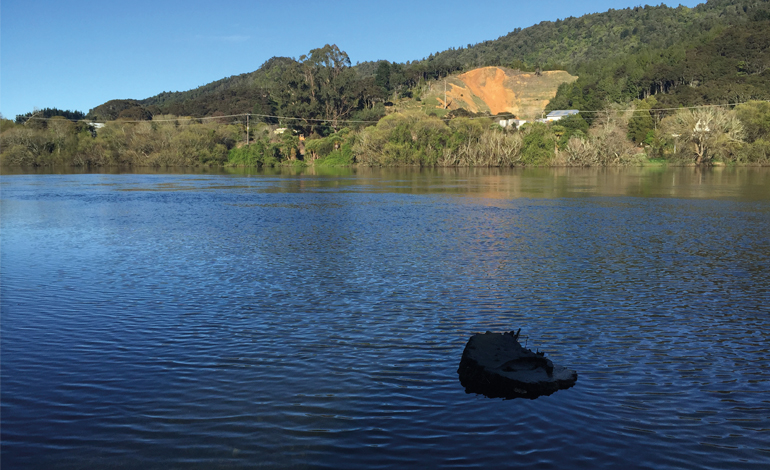Directional or slant drilling is relatively new and a technology that has increased in accuracy over the past decade and has been driven by the oil and minerals sectors.
THE PRACTICE IS NOW common and has become an essential tool in contracting areas such as trenching of underground utilities including telephone, power and water.
Currently, directional drilling can go as deep as 30 metres in this country without requiring expertise to be brought in from Australia, says Neil Vanner at Universal Underground, a Kiwi directional drilling specialist company.
Over many years slant drilling technology was developed for the oil well-drilling industry to directionally steer the vertical drill head into oil rich seams deep below ground.
It was soon realised that this technology could be adapted in a smaller scale for the infrastructure industry. The first very basic Horizontal Directional Drill (HDD) rig landed in New Zealand in 1989 and was put to work in Te Puke installing gas pipe.
Previous to this, trenchless technology for small infrastructure involved rod pushers and pneumatic moles (called “thrusting”, a term still heard today to wrongly describe HDD).
Directional drilling here has progressed in leaps and bounds from these early days, when the old horizontal drills required the operator to walk up and down the machine as new rods were loaded by hand. The electronics developed to locate the drill head were very primitive and only worked to a shallow depth with very limited telemetry information.
Twenty-five years on it’s easy to see how HDD has revolutionised the underground infrastructure industry in this country. Pipe in ground has become quick and cheap and, in many cases, hidden from public view drilling hundreds of metres underground, and very accurately. No natural or manmade obstacle is an issue any more, and pipe can be installed anywhere, and through anything.
How it works
Three components are measured at any given point in a wellbore in order to determine its position: the depth of the point along the course of the borehole (measured depth), the inclination at the point, and the magnetic azimuth at the point. These three components combined are referred to as a ‘survey’.
Several companies have developed tools that allow directional control while rotating. These tools are referred to as rotary steerable systems (RSS), which is a technology that has made access and directional control possible in previously inaccessible or uncontrollable formations.
- UUL utilises its largest directional drilling rig for the river crossing.
- Pipe being drawn back under the river.
- The pipe was pulled back under the river over a six-hour period.
- Pilot hole drill head exited the ground precisely on target.
- Maori pre-start blessing of the site and drill rig.
- The towing head was removed and the pipeline quickly filled with water to remove the 14 metre external head on the pipe.
Installing a watermain under the Waikato River
The Waikato District Council’s Central District Water Supply Scheme includes a bulk watermain connection between Huntly and Ngaruawahia.
In the old days, such watermains were linked under road or rail bridge crossings, but this has become more complicated as the ownership of such infrastructure changes.
Two decades ago installing a pipeline under the Waikato River was considered high risk, however HDD technology has changed that.
The first stage of this project involved undergrounding a section from Ngaruawahia to Hopuhopu with a 280mm diameter polyethylene pipeline. For archaeological and environmental reasons the entire length was installed by HDD and this included a drill shot beneath the Waikato River. This kept the new pipeline off bridges, improved security, and provided a considerable cost saving.
The HDD project work was carried out by Universal Underground (UUL), a horizontal directional drilling company from Cambridge, which undertook the work as a subcontractor to Spartan Construction from Hamilton.
Tim Mitchell, onsite project manager, drill rig operator and co-owner of UUL, has undertaken a number of drill crossings under the Waikato River. Knowledge and experience counts for a lot when so much is at stake, he says.
“There’s no digging up the drill head if things go wrong.”
The council required the pipe to be placed eight metres below the deepest part of the river. This did not allow traditional drill head tracking and a special transmitter that senses the earth’s magnetic field with an electronic compass was used. This eliminated the requirement to track the head above ground to maintain direction. The in-ground transmitter sent the location information to the drill rig cockpit display via a wire running up inside the drill string. The compass cannot have steel closer than 4.5 metres so the compass housing and rods either side are always manufactured from non-metallic material.
An accurate surveyed long section was undertaken of the riverbed, says Tim, and this information was fed into a computer bore planner along with the underground services to be avoided. The bore planner calculated every millimetre of the crossing and ensured all the targets were met.
Once the pilot hole was completed the drill head and electronic location equipment were removed. A reamer was attached with a swivel and trailing drill rods were then attached to ensure the tunnel was not lost in case of a collapse. On completion of the reaming, the reamer was brought back across the river and reattached to the trailing drill string with the PE pipe connected on behind.
“This project was a textbook river crossing with no effect on the environment,” says Tim.
“The impact to surrounding residences was minimal and all objectives were achieved. From start to finish the river crossing was completed in eight days.”


Parting words from Jeremy Sole- a final column